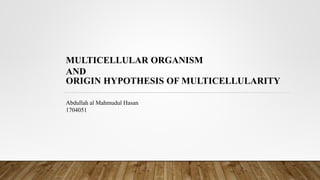
Multicellular Organism And Origin Hypothesis Of Multicellularity
- 1. MULTICELLULAR ORGANISM AND ORIGIN HYPOTHESIS OF MULTICELLULARITY Abdullah al Mahmudul Hasan 1704051
- 2. Multicellular Organism A multicellular organism is an organism that consists of more than one cell, in contrast to a unicellular organism. All species of animals, land plants, and most fungi are multicellular, as are many algae, whereas a few organisms are partially uni- and partially multicellular, like slime molds and amoebae such as the genus Dictyostelium.
- 3. Multicellularity: Origin Hypothesis A group of function-specific cells aggregated into a slug-like mass called a grex, which moved as a multicellular unit. This is essentially what slime molds do. A primitive cell underwent nucleus division, thereby becoming a coenocyte. A membrane would then form around each nucleus thereby resulting in a group of connected cells in one organism (this mechanism is observable in Drosophila). A unicellular organism divided, the daughter cells failed to separate, resulting in a conglomeration of identical cells in one organism, which could later develop specialized tissues. This is what plant and animal embryos do as well as colonial choanoflagellates. Evolution of multicellularity could have occurred in a number of different ways, some of which are described in the next slide...
- 4. The Symbiotic Theory First multicellular organisms occurred from symbiosis (cooperation) of different species of single-cell organisms, each with different roles. Over time these organisms would become so dependent on each other, they would not be able to survive independently, eventually leading to the incorporation of their genomes into one multicellular organism. This kind of severely co-dependent symbiosis can be seen frequently, such as in the relationship between clownfish and sea anemones.
- 5. CONT. • In these cases, it is extremely doubtful whether either species would survive very long if the other became extinct. • Limitation of the theory: It is still not known how each organism's DNA could be incorporated into one single genome to constitute them as a single species.
- 6. The Endosymbiotic Theory The theory states that the eukaryotic cell developed from a large prokaryotic cell engulfing a smaller prokaryotic cell without digesting it. Some eukaryotic cell organelles, such as mitochondria and plastids, evolved from free- living prokaryotes An example of endosymbiosis is the relationship between Rhizobium and the plant legumes. Rhizobium is the endosymbiont that occurs within the roots of legumes. Rhizobium fix atmospheric nitrogen to convert it into a nitrogen form that is ready for use by the legume.
- 7. Figure: Endosymbiosis in a nutshell
- 8. The Cellularization Theory This theory states that a single unicellular organism, with multiple nuclei, could have developed internal membrane partitions around each of its nuclei. Many protists such as the ciliates or slime molds can have several nuclei, lending support to this hypothesis. However, the simple presence of multiple nuclei is not enough to support the theory. To be deemed valid, this theory needs a demonstrable example and mechanism of the generation of a multicellular organism from a pre-existing syncytium.
- 9. The Colonial Theory The colonial theory of Haeckel, 1874, proposes that the symbiosis of many organisms of the same species (unlike the symbiotic theory) led to a multicellular organism. Advantage of this hypothesis is that it has been seen to occur independently in 16 different protoctistan phyla. For instance, during food shortages the amoeba Dictyostelium groups together in a colony that moves as one to a new location. Some of these amoebae then slightly differentiate from each other.
- 10. Figure: The colonial theory- colonial flagellate hypothesis
- 11. Predation Hypothesis The predation hypothesis suggests that in order to avoid being eaten by predators, simple single-celled organisms evolved multicellularity to make it harder to be consumed as prey. Herron et al. performed laboratory evolution experiments on the single-celled green alga, Chlamydomonas reinhardtii, using paramecium as a predator. They found that in the presence of this predator, C. reinhardtii does indeed evolve simple multicellular features.
- 12. THANKS TO ALL...
